Systematic Categorization of Optimization Strategies for Virtual Power Plants
Abstract
1. Introduction
2. Framework and the Key Contributions
- To classify different optimization strategies for VPP based on system configuration, parameters, and control techniques.
- To summarize the methodology and objectives of every optimization scheme for VPP and to demonstrate the most feasible control scheme to maximize the profits with minimum cost.
- To depict the procedure of control flow of VPP that consists of DERs and ESSs.
- To perceive the market utilities and consumers demand responses and to designate the necessary model to deal with the electricity market.
- To analyze the causes for uncertainties in the electricity market and to demonstrate the necessary techniques to eliminate the uncertainties.
3. Methodology
4. Virtual Power Plants
4.1. Commercial Virtual Power Plant
4.2. Technical Virtual Power Plant
4.3. Objective Functions and Constraints
5. Virtual Power Plant Optimization Models, Techniques, and Algorithms
5.1. Conventional VPP Optimization Strategy
5.2. Offering Model
5.3. Optimization Algorithm Based on Intelligent Techniques
- (i)
- Load distribution by generation units with priority level and
- (ii)
- Load distribution by generation units equally. Another, MAS for VPP is presented in [93] to control the generation units’ carbon emissions.
5.4. Priced-Based Unit Commitment (PBUC) Model
5.5. Optimal Bidding Strategy
5.6. Optimization Algorithm Based on Linear Programming
5.7. Optimization Algorithm Based on Stochastic Technique
6. Conclusions and Future Directions
- The offering strategy that utilizes wind power and demand responses overcomes the intermittence problem in the electricity market. The system also balances the electricity market prices with an improving profit. A fast-computation can be achieved if the offering model is combined with stochastic programming.
- Like fuzzy logic, intelligent control can maintain priority management among suppliers, consumers, and demand responses. Furthermore, a flexible smart grid can be established using MAS that includes ANN, level-based approach, and EVPP.
- PBUC method utilizes DERs in DA market scheduling to handle uncertainties in the electricity market.
- Bidding strategies (BSs) can maximize profits. The BSs with two-stage robust optimization can eliminate uncertainties along with maximizing profits. The security can also be ensured by BDT based BS.
- DLC, based on linear programming, successfully handles both the transmission and distribution system. CCS can govern power in a broader range. Linear programming-based control maximizes profits as well as lessens risk.
- Bi-level or multi-level stochastic optimization can deal with uncertainty parameters such as wind power generation, DA market scheduling, and ultimately provides maximum profits.
Author Contributions
Funding
Acknowledgments
Conflicts of Interest
Abbreviations
| ABC | Agent-Based Control |
| ABP | Agent-Based Approach |
| ALDFS | Adaptive Load Dispatching and Forecasting Strategy |
| ANN | Artificial Neural Network |
| BDT | Bender Decomposition Technique |
| BLMOA | Bi-Level Multi-Objective Approach |
| BLSSOM | Bi-Level Stochastic Scheduling Optimization Mode |
| BM | Business Model |
| CCC | Control Coordination Center |
| CCS | Coordinated Control Strategy |
| CGT | Conventional Gas Turbine |
| CHP | Combined Heat and Power |
| CIDOA | Combined Interval and Deterministic Optimization |
| CPP | Conventional Power Plant |
| COA | Combined Optimization Algorithm |
| CVaR | Conditional Value at Risk |
| DA | Day-Ahead |
| DER | Distributed Energy Resources |
| DG | Distributed Generation |
| DHDCA | Direct, Hierarchical and Distributed Control Approach |
| DLCM | Direct Load Control Model |
| DSM | Demand Side Management |
| DSO | Distribution System Operator |
| EEX | European Energy Exchange |
| EMM | Energy Management Model |
| EMS | Energy Management System |
| EPEX | European Power Exchange |
| ESS | Energy Storage System |
| EVMM | Electric Vehicle Management Module |
| FC | Fuel Cell |
| FLC | Fuzzy Logic Control |
| FMOOA | Fuzzy Multiple Objective Optimization Algorithm |
| FRS | Frequency Regulation Strategy |
| FSD | First-Order Stochastic Dominance |
| GDCS | Generation Driver Control Strategy |
| IAS | Intelligent Autocontrol System |
| IM | Instant Messaging |
| IOE | Internet of Energy |
| IVPP | Industrial Virtual Power Plant |
| KKT | Karush-Kuhn-Tucker |
| LWC | Levelized Fresh Water Cost |
| MAS | Multi-Agent System |
| MBM | Market-Based Model |
| MCOS | Multi-Criteria Operation Strategy |
| MILP | Mixed Integer Linear Programming |
| MM | Mathematical Model |
| MORSM | Multi-Objective Robust Stochastic Model |
| MOSS | Multi-Objective Stochastic Scheduling |
| MRTS | Mixed Rental Treading Strategy |
| NDRM | Novel Demand Response Model |
| NLMT | Non-Linear Minimization Technique |
| NLMIPM | Non-Linear Mixed Integer Programming Model |
| NOS | Novel Optimal Scheduling |
| NSPA | Novel Stochastic Programming Approach |
| OA | Optimization Algorithm |
| OBS | Optimal Bidding Strategy |
| ODS | Optimal Dispatch Scheduling |
| OOM | Offering Optimization Model |
| OS | Offering Strategy |
| PBUC | Price-Based Unit Commitment |
| PEM | Point Estimate Model |
| PM | Probabilistic Method |
| PSO | Particle Swarm Optimization |
| PV | Photovoltaic |
| RAM | Risk Aversion Model |
| RES | Renewable Energy Resources |
| RHS | Risk Hedging Strategy |
| RT | Real-Time |
| RTS | Reliability Test System |
| SAEV | Standard Autonomous Electric Vehicle |
| SAROS | Stochastic Adaptive Robust Optimization Scheme |
| SCADA | Supervisory Control and Data Acquisition |
| SDM | Stochastic and Deterministic Model |
| SOA | Service-Oriented Architecture |
| SPBSA | Stochastic Profit-Based Scheduling Approach |
| TPA | Trip Prediction Algorithm |
| TRM | Two Risk Management |
| TRM | Two Risk Management |
| TSO | Transmission System Operator |
| TSOSM | Two-Stage Optimal Scheduling Model |
| TSSP | Two-Stage Stochastic Programming |
| TVPP | Technical Virtual Power Plant |
| VOIP | Voice Over IP |
Nomenclature
| The total fuel cost for all the energy resources | |
| The cost of electric energy in terms of grid | |
| Heat generator | |
| Power generator | |
| Combined heat and power plant | |
| The total cost | |
| The weighted average of the electricity cost | |
| β | The deterministic factor |
| ξ | The degree of pessimism of the distribution market |
| The random forecasted values | |
| Deterministic profits | |
| The total hourly load of VPP | |
| The hourly DA wholesale market prices | |
| The total system disutility | |
| , | The forecasted and scenario-dependent prices in the electricity market, respectively |
| The scenario-based electricity demand | |
| The scheduled served electricity demand in period t and zone z | |
| The probability of occurrence of scenario ω in period t | |
| , | The spinning reserve market price, VPP’s retail energy rate, and considered penalty of non-reserved in period t respectively. |
| The number of device off | |
| The number of devices operating under curtailed power | |
| The number of devices operating under normal rated power | |
| The price of earned energy from EP u during period t | |
| The price of gasoline during time t | |
| The energy supply by EP u during period t | |
| The average gasoline usage of PHEV | |
| The depth of discharge (DOD) for PHEV v during period t | |
| The probable battery replacement cost as a function of DOD | |
| The charge-sustaining (CS) mode during period t by PHEV v | |
| The charge energy | |
| The cost of the battery | |
| The life of the battery in equivalent full cycle | |
| The cost function of DG | |
| The cost function of the grid | |
| The battery cost during opposite aging | |
| , | The probability of the down-regulation and up-regulation price scenario, respectively |
| , | The down-regulation and up-regulation price ratio in time t respectively |
| , | The power sell and purchase in balancing market, respectively |
| The CPP start-up cost | |
| The total cost of the CPP electricity production | |
| The DA market price in time t and scenario p | |
| Annual electricity that is not supplied or brought from the grid | |
| The value of the lost load | |
| The annual hydrogen production | |
| The annual freshwater production | |
| The annual electricity brought from the grid | |
| The total generated electricity | |
| The electricity price of the grid | |
| The curtailment value of dispatchable load in an hour | |
| The cost of an interruptible consumer to curtail its load in an hour | |
| , , | The binary decision (on = 1, off = 0) for DG unit status, start-up and shunt down in hours, respectively |
| , | The generation costs of dispatchable and stochastic DG unit, respectively |
| , | The start-up and shut down the cost of DG unit, respectively |
| The total forecasted load of VPP | |
| , | The shut up and shut down the cost of DG |
| The price of the energy market | |
| The price of spinning reserve market | |
| The retail energy rate of VPP | |
| The unserved load for trading in the energy market | |
| The generation of DG in the energy market | |
| The day-ahead market | |
| The electricity sells | |
| The electricity purchase | |
| B | The importance of risk minimization |
| The function of the cost of electricity production from CPP | |
| 1 when CPP is started from the beginning period t and is 0 at other cases | |
| The startup cost of CHP | |
| The earnings from selling thermal energy | |
| The earnings from selling electrical energy | |
| The fuel and operational cost of CHP | |
| The fuel and operational cost of the boiler | |
| α | The setting confident level |
| The auxiliary variable to compute CaVR | |
| The probability of occurrence of scenario ω | |
| The profit realized in time t and scenario ω | |
| The exchange power between VPP and spinning reserve market at hour t and scenario s | |
| The served electric load power ai time t, zone z, and scenario s | |
| , , | The first, second, and third-level electric load curtailment respectively of DR at hour t, zone z, and scenario s |
| The amount of unserved energy in zone z, hour t, and scenario s | |
| The cross power of upstream line ai zone z and hour t | |
| The heating value of natural gas | |
| , | The boiler efficiency and CHP electrical efficiency in zone z, respectively |
References
- Pudjianto, D.; Ramsay, C.; Strbac, G. Virtual power plant and system integration of distributed energy resources. IET Renew. Power Gener. 2007, 1, 10–16. [Google Scholar] [CrossRef]
- Peik-Herfeh, M.; Seifi, H.; Sheikh-El-Eslami, M.K. Decision making of a virtual power plant under uncertainties for bidding in a day-ahead market using point estimate method. Int. J. Electr. Power Energy Syst. 2013, 44, 88–98. [Google Scholar] [CrossRef]
- Ziogou, C.; Ipsakis, D.; Seferlis, P.; Bezergianni, S.; Papadopoulou, S.; Voutetakis, S. Optimal production of renewable hydrogen-based on an efficient energy management strategy. Energy 2013, 55, 58–67. [Google Scholar] [CrossRef]
- Vessey, A. The Virtual Utility: Accounting, Technology & Competetive Aspects of the Emerging Industry; Awerbuch, S., Preston, A., Eds.; Springer: New York, NY, USA, 1997; pp. 43–55. [Google Scholar]
- Jenkins, N. Secretary of the CIRED Working Group No. 4 on Dispersed Generation; Preliminary Report for Discussion at CIRED: Nice, France, 1–4 June 1999. [Google Scholar]
- Moradi, M.H.; Abedini, M. A combination of genetic algorithm and particle swarm optimization for optimal DG location and sizing in distribution systems. Int. J. Electr. Power Energy Syst. 2012, 34, 66–74. [Google Scholar] [CrossRef]
- Rotaru, F.; Chicco, G.; Grigoras, G.; Cartina, G. Two-stage distributed generation optimal sizing with clustering-based node selection. Int. J. Electr. Power Energy Syst. 2012, 40, 120–129. [Google Scholar] [CrossRef]
- Porkar, S.; Poure, P.; Abbaspour-Tehrani-fard, A.; Saadate, S. A novel optimal distribution system planning framework implementing distributed generation in a deregulated electricity market. Electr. Power Syst. Res. 2010, 80, 828–837. [Google Scholar] [CrossRef]
- Podder, A.K.; Roy, N.K.; Pota, H.R. MPPT methods for solar PV systems: A critical review based on trcking nature. IET Renew. Power Gener. 2019, 13, 1615–1632. [Google Scholar] [CrossRef]
- Houwing, M.; Ajah, A.N.; Heijnen, P.W.; Bouwmans, I.; Herder, P.M. Uncertainties in the design and operation of distributed energy resources: The case of micro-CHP systems. Energy 2008, 33, 1518–1536. [Google Scholar] [CrossRef]
- Algarni, A.A.; Bhattacharya, K. Disco operation considering DG units and their goodness factors. IEEE Trans. Power Syst. 2009, 24, 1831–1840. [Google Scholar] [CrossRef]
- Keane, A.; Zhou, Q.W.; Bialek, J.; O’Malley, M. Planning and operating non-firm distributed generation. IET Renew. Power Gener. 2009, 3, 455–464. [Google Scholar] [CrossRef]
- Dielmann, K.; van der Velden, A. Virtual power plants (VPP)-a new perspective for energy generation? In Proceedings of the 9th International Scientific and Practical Conference of Students, Post-Graduates Modern Techniques and Technologies, Tomsk, Russia, 7–11 April 2003; pp. 18–20. [Google Scholar]
- El Bakari, K.; Kling, W.L. Virtual power plants: An answer to increasing distributed generation. In Proceedings of the 2010 IEEE PES Innovative Smart Grid Technologies Conference Europe (ISGT Europe), Gothenberg, Sweden, 11–13 October 2010; pp. 1–6. [Google Scholar]
- Loßner, M.; Böttger, D.; Bruckner, T. Economic assessment of virtual power plants in the German energy market—A scenario-based and model-supported analysis. Energy Econ. 2017, 62, 125–138. [Google Scholar] [CrossRef]
- Sigrimis, N.; Arvanitis, K.; Pasgianos, G.; Ferentinos, K. Computer integrated management and intelligent control of greenhouses. Environ. Cont. Biol. 2002, 40, 39–53. [Google Scholar] [CrossRef]
- Nikonowicz, Ł.B.; Milewski, J. Virtual power plants-general review: Structure, application, and optimization. J. Power Technol. 2012, 92, 135–149. [Google Scholar]
- Kolenc, M. Virtual power plant architecture using OpenADR 2.0b for dynamic charging of automated guided vehicles. Int. J. Electr. Power Energy Syst. 2019, 104, 370–382. [Google Scholar] [CrossRef]
- Mahmud, K.; Khan, B.; Ravishankar, J.; Ahmadi, A.; Siano, P. An internet of energy framework with distributed energy resources, prosumers, and small-scale virtual power plants: An overview. Renew. Sustain. Energy Rev. 2020, 127, 1–19. [Google Scholar] [CrossRef]
- Binding, C. Electric vehicle fleet integration in the Danish EDISON project-a virtual power plant on the island of Bornholm. In Proceedings of the IEEE PES General Meeting, Providence, RI, USA, 25–29 July 2010; pp. 1–8. [Google Scholar]
- Cheng, L.; Zhou, X.; Yun, Q.; Tian, L.; Wang, X.; Liu, Z. A Review on Virtual Power Plants Interactive Resource Characteristics and Scheduling Optimization. In Proceedings of the 2019 IEEE 3rd Conference on Energy Internet and Energy System Integration (EI2), Changsha, China, 8–10 November 2019; pp. 514–519. [Google Scholar]
- Kieny, C.; Berseneff, B.; Hadjsaid, N.; Besanger, Y.; Maire, J. On the concept and the interest of virtual power plant: Some results from the European project Fenix. In Proceedings of the 2009 IEEE Power & Energy Society General Meeting, Calgary, AB, Canada, 26–30 July 2009; pp. 1–6. [Google Scholar]
- Chung, B.J.; Kim, C.S.; Son, S.-Y. Analysis of the Virtual Power Plant Model Based on the Use of Emergency Generators in South Korea. J. Electr. Eng. Technol. 2016, 11, 38–46. [Google Scholar] [CrossRef][Green Version]
- Dudek, M.; Ropuszyńska-Surma, E.; Węglarz, M.; Suwała, W.; Łopata, S.; Leszczyński, J. The Virtual Power Plant—A Review Of Business Models. In Proceedings of the E3S Web of Conferences, Krakow, Poland, 19–21 September 2018; pp. 1–6. [Google Scholar]
- Schulz, C.; Roder, G.; Kurrat, M. Virtual power plants with combined heat and power micro-units. In Proceedings of the 2005 International Conference on Future Power Systems, Amsterdam, The Netherlands, 18 November 2005; pp. 1–5. [Google Scholar]
- Andersen, P.B.; Poulsen, B.; Decker, M.; Træholt, C.; Ostergaard, J. Evaluation of a generic virtual power plant framework using service oriented architecture. In Proceedings of the 2008 IEEE 2nd International Power and Energy Conference, Johor Bahru, Malaysia, 1–3 December 2008; pp. 1212–1217. [Google Scholar]
- Sikorski, T. A Case Study on Distributed Energy Resources and Energy-Storage Systems in a Virtual Power Plant Concept: Technical Aspects. Energie 2020, 13, 3086. [Google Scholar] [CrossRef]
- Yu, S.; Fang, F.; Liu, Y.; Liu, J. Uncertainties of virtual power plant: Problems and countermeasures. Appl. Energy 2019, 239, 454–470. [Google Scholar] [CrossRef]
- Etherden, N.; Vyatkin, V.; Bollen, M.H.J. Virtual Power Plant for Grid Services Using IEC 61850. IEEE Trans. Ind. Inform. 2016, 12, 437–447. [Google Scholar] [CrossRef]
- Ghavidel, S.; Li, L.; Aghaei, J.; Yu, T.; Zhu, J. A review on the virtual power plant: Components and operation systems. In Proceedings of the 2016 IEEE International Conference on Power System Technology (POWERCON), Wollongong, NSW, Australia, 28 September–1 October 2016; pp. 1–6. [Google Scholar]
- Heo, J.S.; Lee, K.Y. A multi-agent system-based intelligent identification system for power plant control and fault-diagnosis. In Proceedings of the 2006 IEEE Power Engineering Society General Meeting, Montreal, QC, Canada, 18–22 June 2006; pp. 1–6. [Google Scholar]
- Roossien, B.; Hommelberg, M.; Warmer, C.; Kok, K.; Turkstra, J.-W. Virtual power plant field experiment using 10 micro-CHP units at consumer premises. In Proceedings of the CIRED Seminar 2008: SmartGrids for Distribution, Frankfurt, Germany, 23–24 June 2008; pp. 1–4. [Google Scholar]
- Palizban, O.; Kauhaniemi, K.; Guerrero, J.M. Microgrids in active network management—Part I: Hierarchical control, energy storage, virtual power plants, and market participation. Renew. Sustain. Energy Rev. 2014, 36, 428–439. [Google Scholar] [CrossRef]
- Pal, P.; Parvathy, A.; Devabalaji, K. A broad review on optimal operation of Virtual power plant. In Proceedings of the 2019 2nd International Conference on Power and Embedded Drive Control (ICPEDC), Chennai, India, 21–23 August 2019; pp. 400–405. [Google Scholar]
- Zhang, G.; Jiang, C.; Wang, X. Comprehensive review on structure and operation of virtual power plant in electrical system. IET Gener. Trans. Distrib. 2019, 13, 145–156. [Google Scholar] [CrossRef]
- Shabanzadeh, M.; Sheikh-El-Eslami, M.-K.; Haghifam, M.-R. A medium-term coalition-forming model of heterogeneous DERs for a commercial virtual power plant. Appl. Energy 2016, 169, 663–681. [Google Scholar] [CrossRef]
- Giuntoli, M.; Poli, D. Optimized thermal and electrical scheduling of a large scale virtual power plant in the presence of energy storages. IEEE Trans. Smart Grid 2013, 4, 942–955. [Google Scholar] [CrossRef]
- Othman, M.M.; Hegazy, Y.; Abdelaziz, A.Y. A Review of virtual power plant definitions, components, framework and optimization. Int. Electr. Eng. J. 2015, 6, 2010–2024. [Google Scholar]
- Baringo, A.; Baringo, L. A stochastic adaptive robust optimization approach for the offering strategy of a virtual power plant. IEEE Trans. Power Syst. 2016, 32, 3492–3504. [Google Scholar] [CrossRef]
- Arslan, O.; Karasan, O.E. Cost and emission impacts of virtual power plant formation in plug-in hybrid electric vehicle penetrated networks. Energy 2013, 60, 116–124. [Google Scholar] [CrossRef]
- Nezamabadi, H.; Nazar, M.S. Arbitrage strategy of virtual power plants in energy, spinning reserve and reactive power markets. IET Gener. Transm. Distrib. 2016, 10, 750–763. [Google Scholar] [CrossRef]
- Wang, Y.; Ai, X.; Tan, Z.; Yan, L.; Liu, S. Interactive dispatch modes and bidding strategy of multiple virtual power plants based on demand response and game theory. IEEE Trans. Smart Grid 2015, 7, 510–519. [Google Scholar] [CrossRef]
- Cui, H.; Li, F.; Hu, Q.; Bai, L.; Fang, X. Day-ahead coordinated operation of utility-scale electricity and natural gas networks considering demand response based virtual power plants. Appl. Energy 2016, 176, 183–195. [Google Scholar] [CrossRef]
- Wille-Haussmann, B.; Erge, T.; Wittwer, C. Decentralised optimisation of cogeneration in virtual power plants. Sol. Energy 2010, 84, 604–611. [Google Scholar] [CrossRef]
- Yang, H.; Yi, D.; Zhao, J.; Dong, Z. Distributed optimal dispatch of virtual power plant via limited communication. IEEE Trans. Power Syst. 2013, 28, 3511–3512. [Google Scholar] [CrossRef]
- Hernández, L. A multi-agent system architecture for smart grid management and forecasting of energy demand in virtual power plants. IEEE Commun. Mag. 2013, 51, 106–113. [Google Scholar] [CrossRef]
- Zamani, A.G.; Zakariazadeh, A.; Jadid, S. Day-ahead resource scheduling of a renewable energy based virtual power plant. Appl. Energy 2016, 169, 324–340. [Google Scholar] [CrossRef]
- Nosratabadi, S.M.; Hooshmand, R.-A.; Gholipour, E. Stochastic profit-based scheduling of industrial virtual power plant using the best demand response strategy. Appl. Energy 2016, 164, 590–606. [Google Scholar] [CrossRef]
- Fan, S.; Ai, Q.; Piao, L. Fuzzy day-ahead scheduling of virtual power plant with optimal confidence level. IET Gener. Transm. Distrib. 2016, 10, 205–212. [Google Scholar] [CrossRef]
- Dietrich, K.; Latorre, J.M.; Olmos, L.; Ramos, A. Modelling and assessing the impacts of self supply and market-revenue driven Virtual Power Plants. Electr. Power Syst. Res. 2015, 119, 462–470. [Google Scholar] [CrossRef]
- Soares, J.; Borges, N.; Lobo, C.; Vale, Z. VPP energy resources management considering emissions: The case of Northern Portugal 2020 to 2050. In Proceedings of the 2015 IEEE Symposium Series on Computational Intelligence, Cape Town, South Africa, 7–10 December 2015; pp. 1259–1266. [Google Scholar]
- Cheng, H.; Gao, Y.; Zhang, J.; Li, R.; Liang, H. The power system multi-objective optimization dispatching containing virtual power plant. In Proceedings of the 2014 International Conference on Power System Technology, Chengdu, China, 20–22 October 2014; pp. 3316–3321. [Google Scholar]
- Sučić, S.; Dragičević, T.; Capuder, T.; Delimar, M. Economic dispatch of virtual power plants in an event-driven service-oriented framework using standards-based communications. Electr. Power Syst. Res. 2011, 81, 2108–2119. [Google Scholar] [CrossRef]
- Lee, D.; Park, D.; Park, J.-B.; Lee, K.-Y. Security-constrained unit commitment considering demand response resource as virtual power plant. IFAC-PapersOnLine 2016, 49, 290–295. [Google Scholar] [CrossRef]
- Hossain, M.A.; Pota, H.R.; Squartini, S.; Zaman, F.; Muttaqi, K.M. Energy management of community microgrids considering degradation cost of battery. J. Energy Storage 2019, 22, 257–269. [Google Scholar] [CrossRef]
- Petersen, M.K.; Hansen, L.H.; Bendtsen, J.; Edlund, K.; Stoustrup, J. Heuristic optimization for the discrete virtual power plant dispatch problem. IEEE Trans. Smart Grid 2014, 5, 2910–2918. [Google Scholar] [CrossRef]
- Zapata, J.; Vandewalle, J.; D’Haeseleer, W. A comparative study of imbalance reduction strategies for virtual power plant operation. Appl. Therm. Eng. 2014, 71, 847–857. [Google Scholar] [CrossRef]
- Xiao, J.; Kong, X.; Jin, Q.; You, H.; Cui, K.; Zhang, Y. Demand-responsive Virtual Power Plant optimization scheduling method based on competitive bidding equilibrium. Energy Procedia 2018, 152, 1158–1163. [Google Scholar] [CrossRef]
- Vasirani, M.; Kota, R.; Cavalcante, R.L.; Ossowski, S.; Jennings, N.R. An agent-based approach to virtual power plants of wind power generators and electric vehicles. IEEE Trans. Smart Grid 2013, 4, 1314–1322. [Google Scholar] [CrossRef]
- Mnatsakanyan, A.W.; Kennedy, S. A Novel Demand Response Model with an Application for a Virtual Power Plant. IEEE Trans. Smart Grid 2015, 6, 230–237. [Google Scholar] [CrossRef]
- Wei, C. A bi-level scheduling model for virtual power plants with aggregated thermostatically controlled loads and renewable energy. Appl. Energy 2018, 224, 659–670. [Google Scholar] [CrossRef]
- Kumar, K.P.; Saravanan, B.; Swarup, K. A two stage increase-decrease algorithm to optimize distributed generation in a virtual power plant. Energy Procedia 2016, 90, 276–282. [Google Scholar] [CrossRef]
- Mashhour, E.; Moghaddas-Tafreshi, S.M. Bidding Strategy of Virtual Power Plant for Participating in Energy and Spinning Reserve Markets—Part I: Problem Formulation. IEEE Trans. Power Syst. 2011, 26, 949–956. [Google Scholar] [CrossRef]
- Manoj Kumar, N.; Ghosh, A.; Chopra, S.S. Power Resilience Enhancement of a Residential Electricity User Using Photovoltaics and a Battery Energy Storage System under Uncertainty Conditions. Energies 2020, 13, 4193. [Google Scholar] [CrossRef]
- Duan, J. Multi-Objective Virtual Power Plant Construction Model Based on Decision Area Division. Appl. Sci. 2018, 8, 1484. [Google Scholar] [CrossRef]
- Ju, L.; Li, H.; Zhao, J.; Chen, K.; Tan, Q.; Tan, Z. Multi-objective stochastic scheduling optimization model for connecting a virtual power plant to wind-photovoltaic-electric vehicles considering uncertainties and demand response. Energy Convers. Manag. 2016, 128, 160–177. [Google Scholar] [CrossRef]
- Liu, Y.; Li, M.; Lian, H.; Tang, X.; Liu, C.; Jiang, C. Optimal dispatch of virtual power plant using interval and deterministic combined optimization. Int. J. Electr. Power Energy Syst. 2018, 102, 235–244. [Google Scholar] [CrossRef]
- Caldon, R.; Patria, A.R.; Turri, R. Optimisation algorithm for a virtual power plant operation. In Proceedings of the 39th International Universities Power Engineering Conference (UPEC 2004), Bristol, UK, 6–8 September 2004; Volume 3, pp. 1058–1062. [Google Scholar]
- Lombardi, P.; Powalko, M.; Rudion, K. Optimal operation of a virtual power plant. In Proceedings of the 2009 IEEE Power & Energy Society General Meeting, Calgary, AB, Canada, 26–30 July 2009; pp. 1–6. [Google Scholar]
- Tahmasebi, M.; Pasupuleti, J. Self-scheduling of wind power generation with direct load control demand response as a virtual power plant. Indian J. Sci. Techno. 2013, 6, 1–7. [Google Scholar] [CrossRef]
- Raab, A.F. Virtual power plant control concepts with electric vehicles. In Proceedings of the 2011 16th International Conference on Intelligent System Applications to Power Systems, Hersonissos, Greece, 25–28 September 2011; pp. 1–6. [Google Scholar]
- You, S.; Træholt, C.; Poulsen, B. A market-based virtual power plant. In Proceedings of the 2009 International Conference on Clean Electrical Power, Capri, Italy, 9–11 June 2009; pp. 460–465. [Google Scholar]
- Peikherfeh, M.; Seifi, H.; Sheikh-El-Eslami, M.K. Optimal decision making for virtual power plant operation. In Proceedings of the 2010 Conference Proceedings IPEC, Singapore, 27–29 October 2010; pp. 625–629. [Google Scholar]
- Salmani, M.A.; Tafreshi, S.M.; Salmani, H. Operation optimization for a virtual power plant. In Proceedings of the 2009 IEEE PES/IAS Conference on Sustainable Alternative Energy (SAE), Valencia, Spain, 28–30 September 2009; pp. 1–6. [Google Scholar]
- Tascikaraoglu, A.; Erdinc, O.; Uzunoglu, M.; Karakas, A. An adaptive load dispatching and forecasting strategy for a virtual power plant including renewable energy conversion units. Appl. Energy 2014, 119, 445–453. [Google Scholar] [CrossRef]
- Almadhor, A. Intelligent control mechanism in smart micro grid with mesh networks and virtual power plant model. In Proceedings of the 2019 16th IEEE Annual Consumer Communications & Networking Conference (CCNC), Las Vegas, NV, USA, 11–14 January 2019; pp. 1–6. [Google Scholar]
- El Bakari, K.; Kling, W. Fitting distributed generation in future power markets through virtual power plants. In Proceedings of the 2012 9th International Conference on the European Energy Market, Florence, Italy, 10–12 May 2012; pp. 1–7. [Google Scholar]
- Iacobucci, R.; McLellan, B.; Tezuka, T. The synergies of shared autonomous electric vehicles with renewable energy in a virtual power plant and microgrid. Energies 2018, 11, 2016. [Google Scholar] [CrossRef]
- Jansen, B.; Binding, C.; Sundstrom, O.; Gantenbein, D. Architecture and communication of an electric vehicle virtual power plant. In Proceedings of the 2010 First IEEE International Conference on Smart Grid Communications, Gaithersburg, MD, USA, 4–6 October 2010; pp. 149–154. [Google Scholar]
- Ju, L.; Zhao, R.; Tan, Q.; Lu, Y.; Tan, Q.; Wang, W. A multi-objective robust scheduling model and solution algorithm for a novel virtual power plant connected with power-to-gas and gas storage tank considering uncertainty and demand response. Appl. Energy 2019, 250, 1336–1355. [Google Scholar] [CrossRef]
- Kahlen, M.T.; Ketter, W.; van Dalen, J. Electric vehicle virtual power plant dilemma: Grid balancing versus customer mobility. Prod. Oper. Manag. 2018, 27, 2054–2070. [Google Scholar] [CrossRef]
- Yang, J.; Zheng, Q.; Zhao, J.; Guo, X.; Gao, C. Control strategy of virtual power plant participating in the system frequency regulation service. In Proceedings of the 2017 4th International Conference on Systems and Informatics (ICSAI), Hangzhou, China, 11–13 November 2017; pp. 324–328. [Google Scholar]
- Qiu, J.; Meng, K.; Zheng, Y.; Dong, Z.Y. Optimal scheduling of distributed energy resources as a virtual power plant in a transactive energy framework. IET Gener. Transm. Distrib. 2017, 11, 3417–3427. [Google Scholar] [CrossRef]
- Thavlov, A.; Bindner, H.W. Utilization of Flexible Demand in a Virtual Power Plant Set-Up. IEEE Trans. Smart Grid 2015, 6, 640–647. [Google Scholar] [CrossRef]
- Robu, V.; Kota, R.; Chalkiadakis, G.; Rogers, A.; Jennings, N. Cooperative virtual power plant formation using scoring rules. In Proceedings of the Twenty-Sixth AAAI Conference on Artificial Intelligence (AAAI-12), Toronto, AB, Canada, 22 June 2012; pp. 370–376. [Google Scholar]
- Moghaddam, I.G.; Nick, M.; Fallahi, F.; Sanei, M.; Mortazavi, S. Risk-averse profit-based optimal operation strategy of a combined wind farm–cascade hydro system in an electricity market. Renew. Energy 2013, 55, 252–259. [Google Scholar] [CrossRef]
- Pandžić, H.; Morales, J.M.; Conejo, A.J.; Kuzle, I. Offering model for a virtual power plant based on stochastic programming. Appl. Energy 2013, 105, 282–292. [Google Scholar] [CrossRef]
- Mohammadi, J.; Rahimi-Kian, A.; Ghazizadeh, M.S. Aggregated wind power and flexible load offering strategy. IET Renew. Power Gener. 2011, 5, 439–447. [Google Scholar] [CrossRef]
- Pousinho, H.M.I.; Mendes, V.M.F.; da Silva Catalão, J.P. A risk-averse optimization model for trading wind energy in a market environment under uncertainty. Energy 2011, 36, 4935–4942. [Google Scholar] [CrossRef]
- Gong, J.; Xie, D.; Jiang, C.; Zhang, Y. Multiple Objective Compromised Method for Power Management in Virtual Power Plants. Energies 2011, 4, 700–716. [Google Scholar] [CrossRef]
- Dimeas, A.L.; Hatziargyriou, N.D. Agent based control of virtual power plants. In Proceedings of the 2007 International Conference on Intelligent Systems Applications to Power Systems, Toki Messe, Niigata, Japan, 5–8 November 2007; pp. 1–6. [Google Scholar]
- Yousaf, W.; Asghar, E.; Meng, H.; Songyuan, Y.; Fang, F. Intelligent control method of distributed generation for power sharing in virtual power plant. In Proceedings of the 2017 IEEE International Conference on Unmanned Systems (ICUS), Beijing, China, 27–29 October 2017; pp. 576–581. [Google Scholar]
- Skarvelis-Kazakos, S.; Rikos, E.; Kolentini, E.; Cipcigan, L.M.; Jenkins, N. Implementing agent-based emissions trading for controlling Virtual Power Plant emissions. Electr. Power Syst. Res. 2013, 102, 1–7. [Google Scholar] [CrossRef]
- Peik-herfeh, M.; Seifi, H.; Sheikh-El-Eslami, M.K. Two-stage approach for optimal dispatch of distributed energy resources in distribution networks considering virtual power plant concept. Int. Trans. Electr. Energy Syst. 2014, 24, 43–63. [Google Scholar] [CrossRef]
- Kardakos, E.G.; Simoglou, C.K.; Bakirtzis, A.G. Optimal Offering Strategy of a Virtual Power Plant: A Stochastic Bi-Level Approach. IEEE Trans. Smart Grid 2016, 7, 794–806. [Google Scholar] [CrossRef]
- Zdrilić, M.; Pandžić, H.; Kuzle, I. The mixed-integer linear optimization model of virtual power plant operation. In Proceedings of the 2011 8th International Conference on the European Energy Market (EEM), Zagreb, Croatia, 25–27 May 2011; pp. 467–471. [Google Scholar]
- Riveros, J.Z.; Bruninx, K.; Poncelet, K.; D’haeseleer, W. Bidding strategies for virtual power plants considering CHPs and intermittent renewables. Energy Convers. Manag. 2015, 103, 408–418. [Google Scholar] [CrossRef]
- Chaves-Ávila, J.P.; Hakvoort, R.A.; Ramos, A. Short-term strategies for Dutch wind power producers to reduce imbalance costs. Energy Policy 2013, 52, 573–582. [Google Scholar] [CrossRef]
- Rahimiyan, M.; Baringo, L. Strategic bidding for a virtual power plant in the day-ahead and real-time markets: A price-taker robust optimization approach. IEEE Trans. Power Syst. 2016, 31, 2676–2687. [Google Scholar] [CrossRef]
- Mahdavi, S.; Javidi, M. VPP decision making in power markets using Benders decomposition. Int. Trans. Electr. Energy Syst. 2014, 24, 960–975. [Google Scholar] [CrossRef]
- Shafiekhani, M.; Badri, A.; Shafie-Khah, M.; Catalão, J.P. Strategic bidding of virtual power plant in energy markets: A bi-level multi-objective approach. Int. J. Electr. Power Energy Syst. 2019, 113, 208–219. [Google Scholar] [CrossRef]
- Pandžić, H.; Kuzle, I.; Capuder, T. Virtual power plant mid-term dispatch optimization. Appl. Energy 2013, 101, 134–141. [Google Scholar] [CrossRef]
- Tajeddini, M.A.; Rahimi-Kian, A.; Soroudi, A. Risk averse optimal operation of a virtual power plant using two stage stochastic programming. Energy 2014, 73, 958–967. [Google Scholar] [CrossRef]
- Shabanzadeh, M.; Sheikh-El-Eslami, M.-K.; Haghifam, M.-R. An interactive cooperation model for neighboring virtual power plants. Appl. Energy 2017, 200, 273–289. [Google Scholar] [CrossRef]
- Liu, Y.; Xin, H.; Gan, D.; Wang, Z. Control of virtual power plant in microgrids: A coordinated approach based on photovoltaic systems and controllable loads. IET Gener. Transm. Distrib. 2015, 9, 921–928. [Google Scholar] [CrossRef]
- Shabanzadeh, M.; Sheikh-El-Eslami, M.-K.; Haghifam, M.-R. Risk-based medium-term trading strategy for a virtual power plant with first-order stochastic dominance constraints. IET Gener. Transm. Distrib. 2017, 11, 520–529. [Google Scholar] [CrossRef]
- Sowa, T.; Krengel, S.; Koopmann, S.; Nowak, J. Multi-criteria operation strategies of power-to-heat-systems in virtual power plants with a high penetration of renewable energies. Energy Procedia 2014, 46, 237–245. [Google Scholar] [CrossRef]
- Zhou, B.; Cao, Y.; Li, C.; Liu, X.; Chung, C.Y.; Chan, K.W. Optimal scheduling of virtual power plant with battery degradation cost. IET Gener. Transm. Distrib. 2016, 10, 712–725. [Google Scholar] [CrossRef]
- Ruiz, N.; Cobelo, I.; Oyarzabal, J. A Direct load control model for virtual power plant management. IEEE Trans. Power Syst. 2009, 24, 959–966. [Google Scholar] [CrossRef]
- Pasetti, M.; Rinaldi, S.; Manerba, D. A Virtual Power Plant Architecture for the Demand-Side Management of Smart Prosumers. Appl. Sci. 2018, 8, 432. [Google Scholar] [CrossRef]
- Kuzle, I.; Zdrilić, M.; Pandžić, H. Virtual power plant dispatch optimization using linear programming. In Proceedings of the 2011 10th International Conference on Environment and Electrical Engineering, Rome, Italy, 8–11 May 2011; pp. 1–4. [Google Scholar]
- Morais, H.; Kádár, P.; Faria, P.; Vale, Z.A.; Khodr, H. Optimal scheduling of a renewable micro-grid in an isolated load area using mixed-integer linear programming. Renew. Energy 2010, 35, 151–156. [Google Scholar] [CrossRef]
- Garcia-Gonzalez, J.; de la Muela, R.M.R.; Santos, L.M.; Gonzalez, A.M. Stochastic joint optimization of wind generation and pumped-storage units in an electricity market. IEEE Trans. Power Syst. 2008, 23, 460–468. [Google Scholar] [CrossRef]
- Dabbagh, S.R.; Sheikh-El-Eslami, M.K. Risk-based profit allocation to DERs integrated with a virtual power plant using cooperative Game theory. Electr. Power Syst. Res. 2015, 121, 368–378. [Google Scholar] [CrossRef]
- Ju, L.; Tan, Z.; Yuan, J.; Tan, Q.; Li, H.; Dong, F. A bi-level stochastic scheduling optimization model for a virtual power plant connected to a wind–photovoltaic–energy storage system considering the uncertainty and demand response. Appl. Energy 2016, 171, 184–199. [Google Scholar] [CrossRef]
- Candra, D.; Hartmann, K.; Nelles, M. Economic Optimal Implementation of Virtual Power Plants in the German Power Market. Energies 2018, 11, 2365. [Google Scholar] [CrossRef]
- Zamani, A.G.; Zakariazadeh, A.; Jadid, S.; Kazemi, A. Stochastic operational scheduling of distributed energy resources in a large scale virtual power plant. Int. J. Electr. Power Energy Syst. 2016, 82, 608–620. [Google Scholar] [CrossRef]
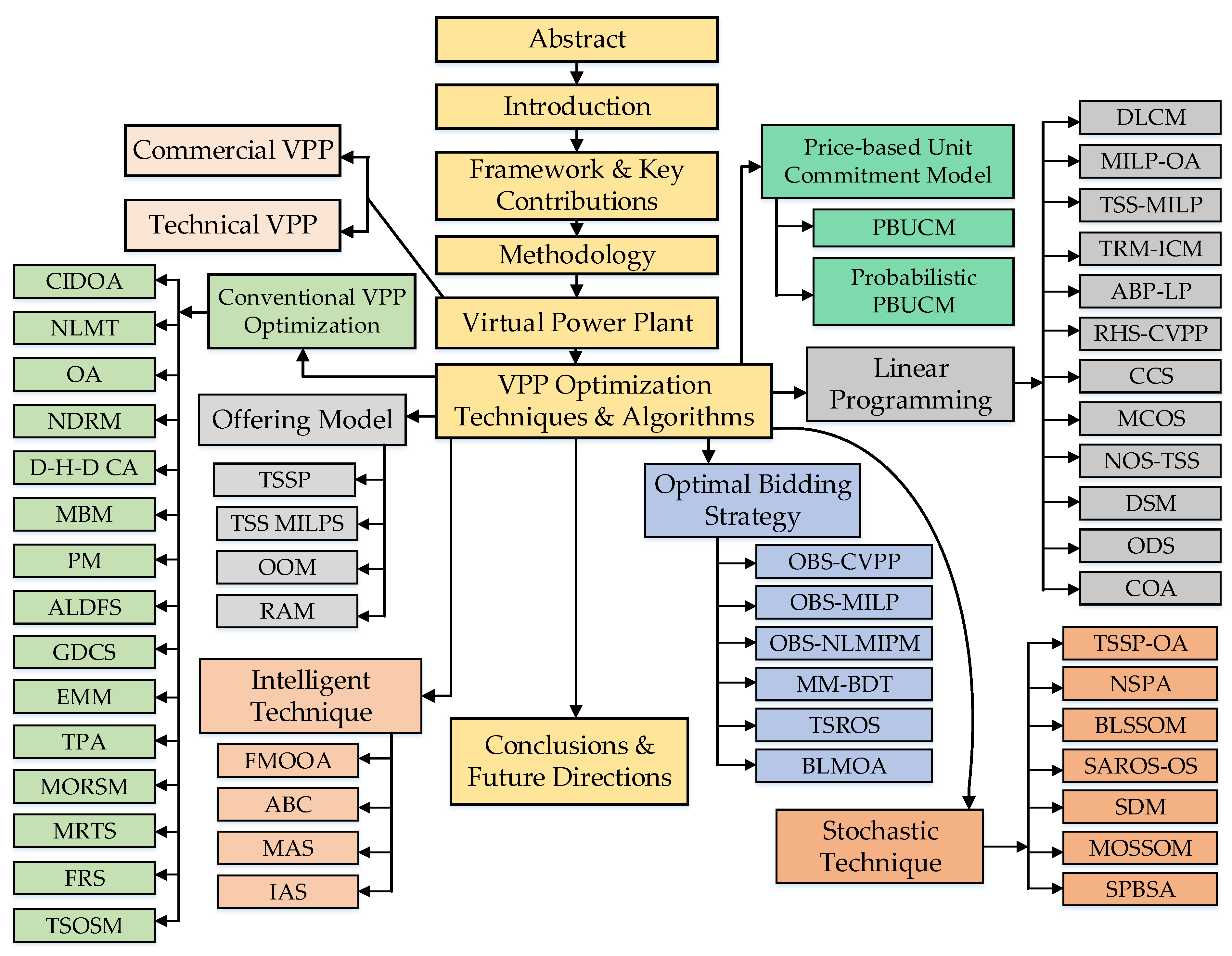

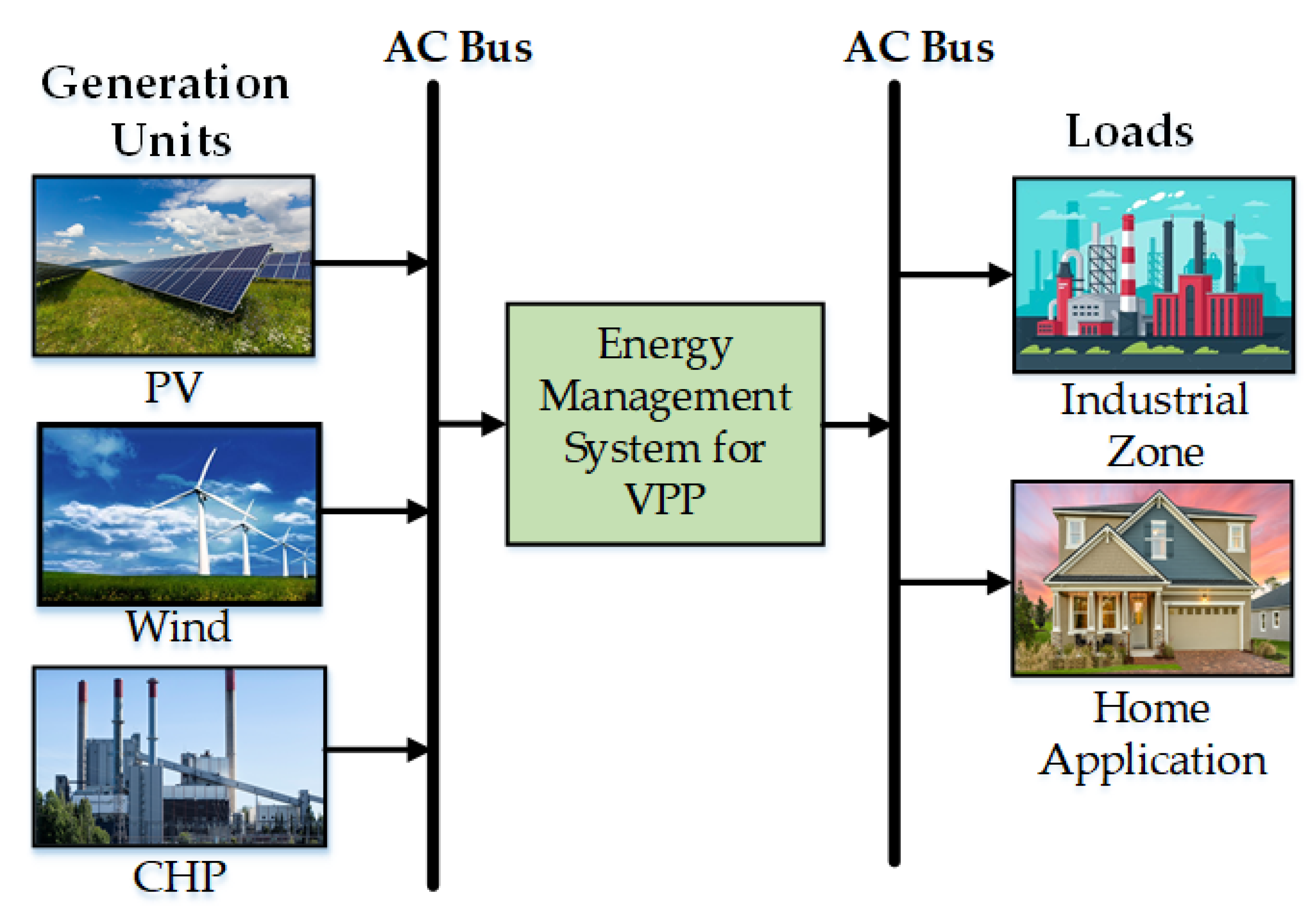
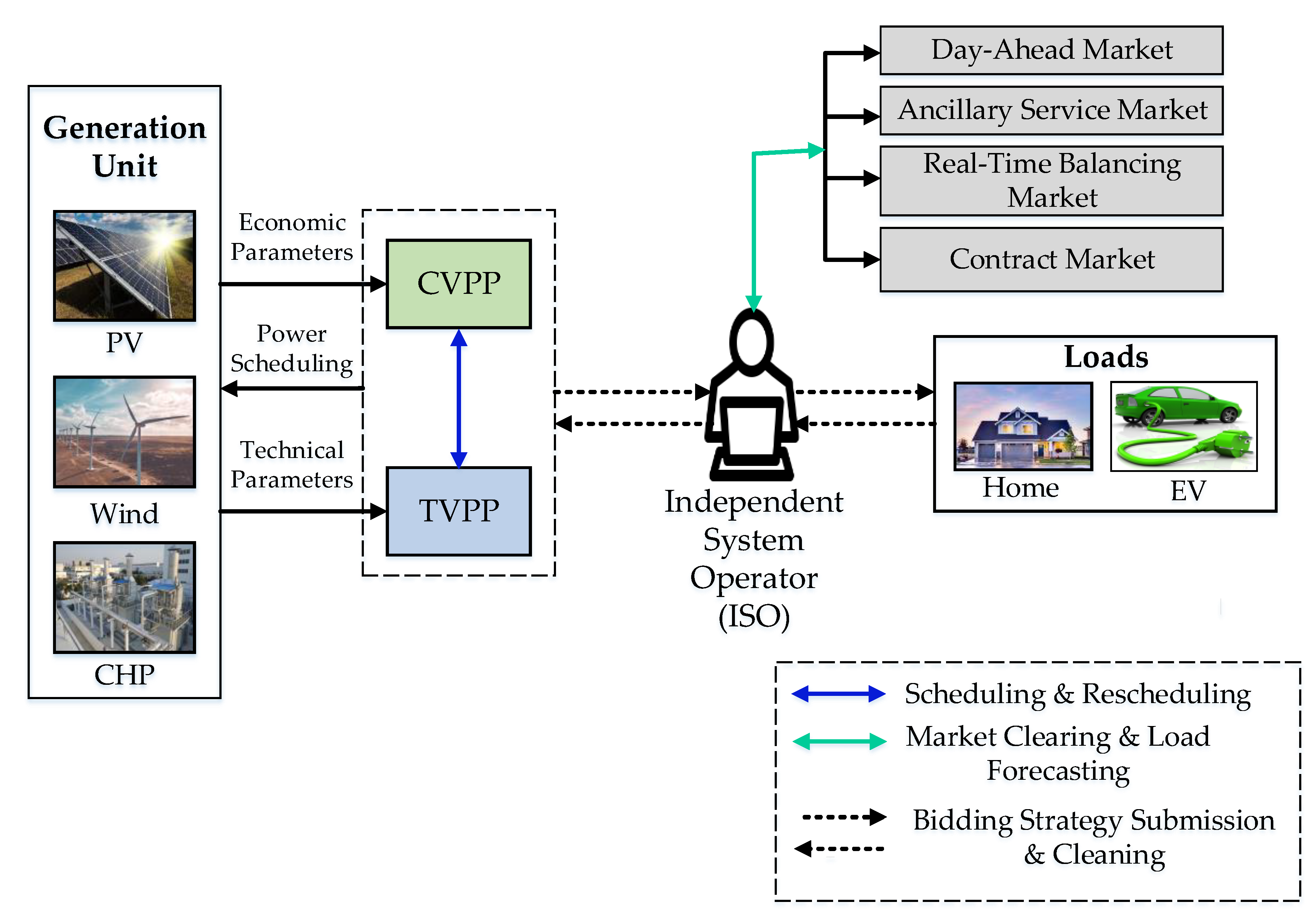
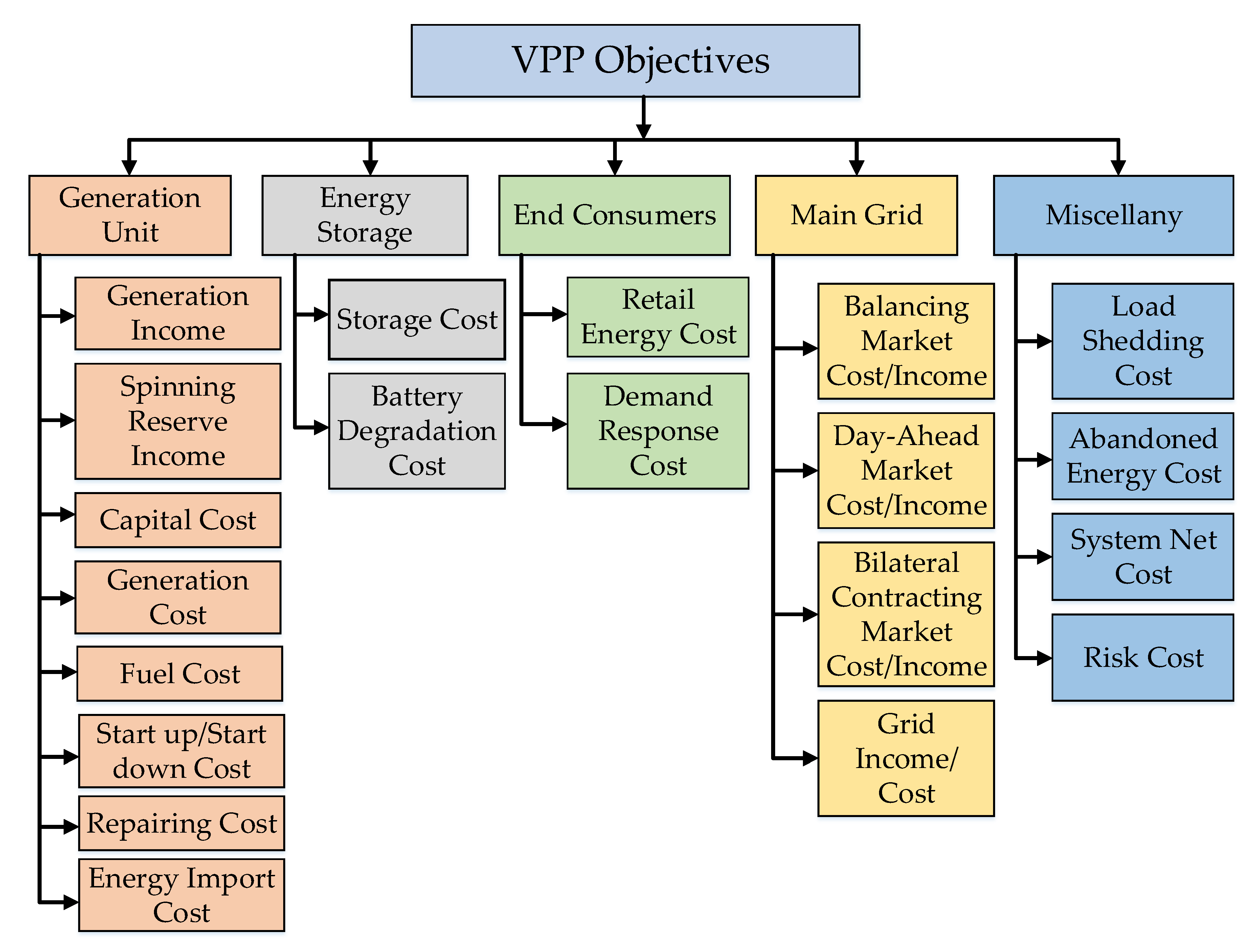


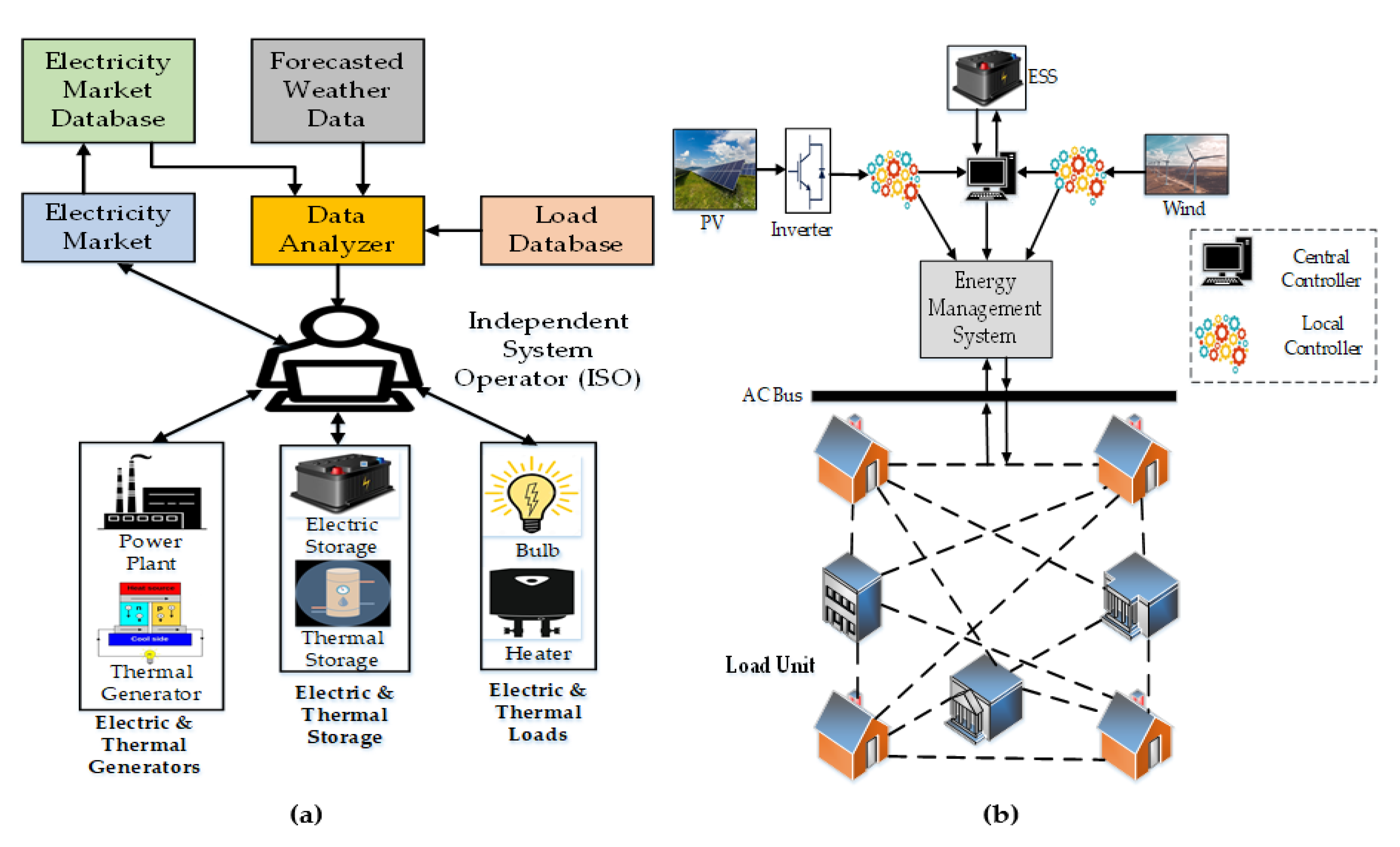

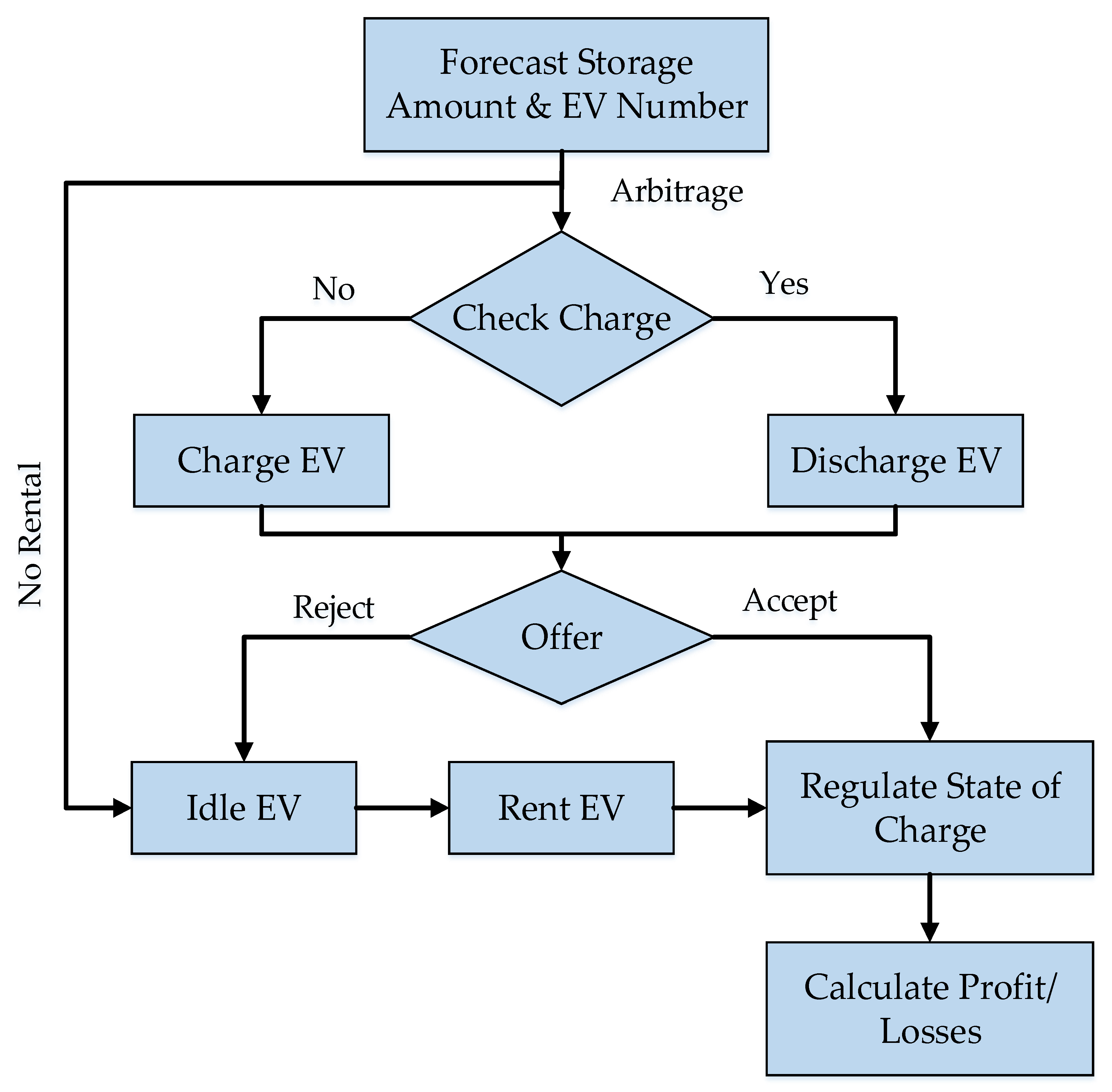
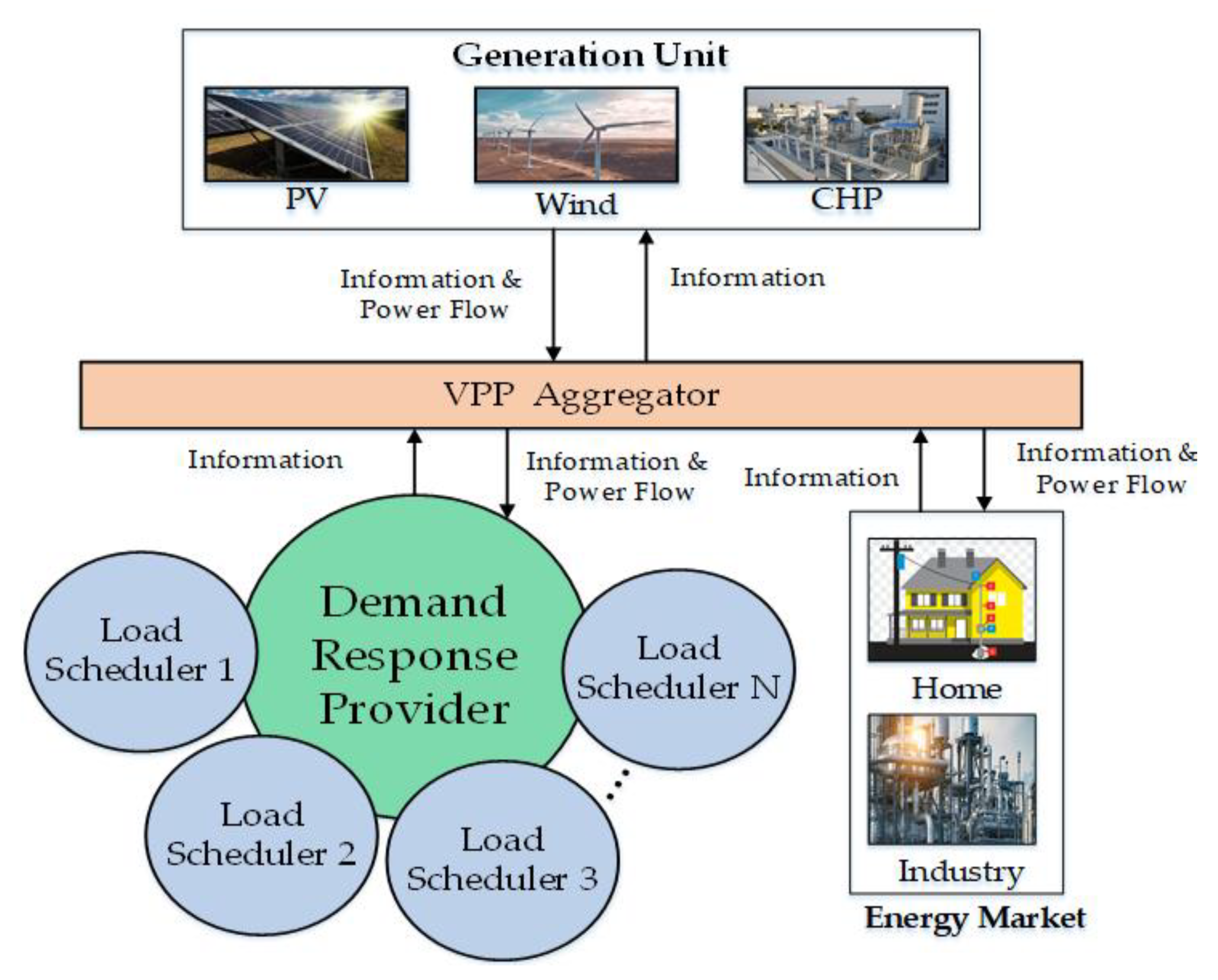
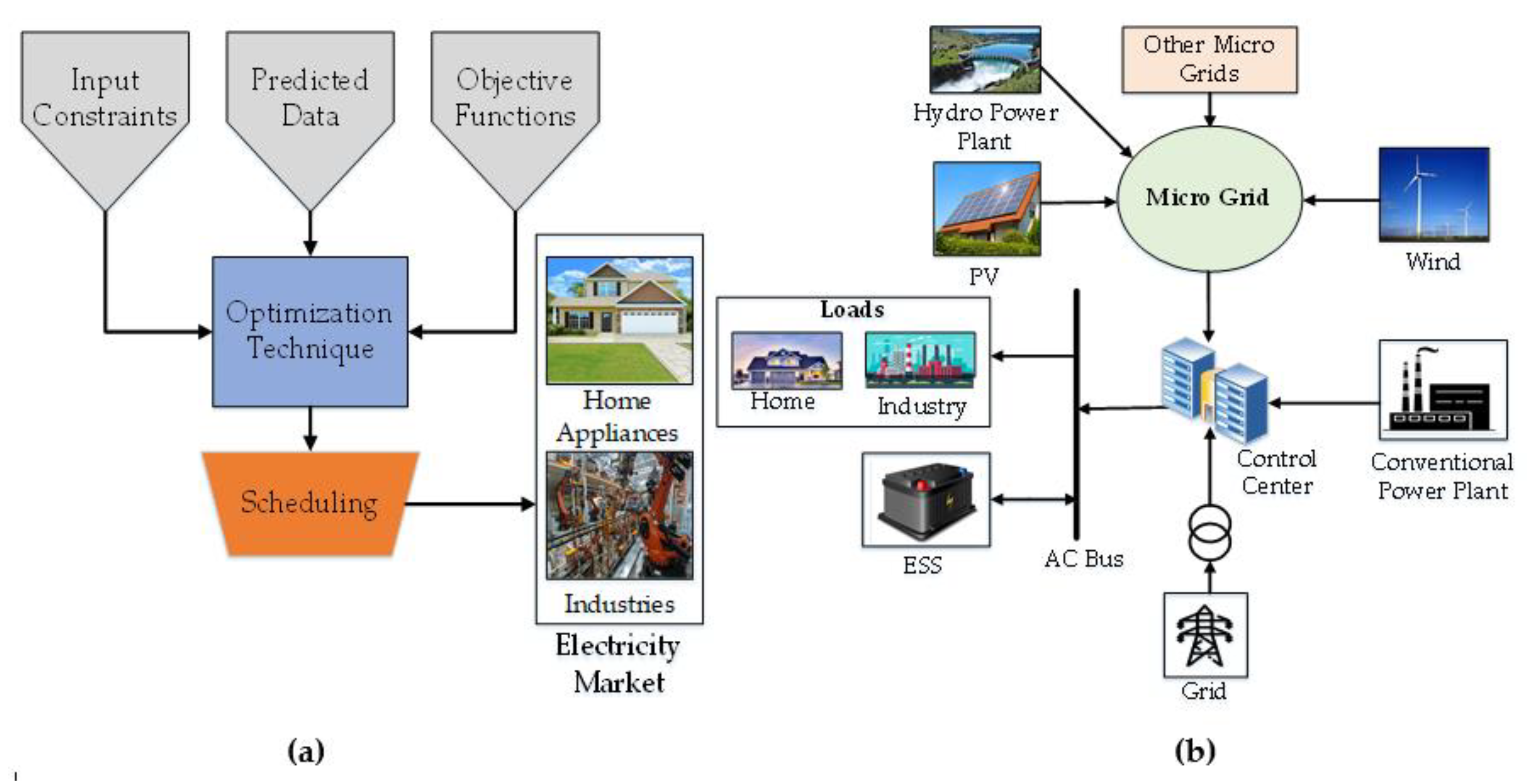

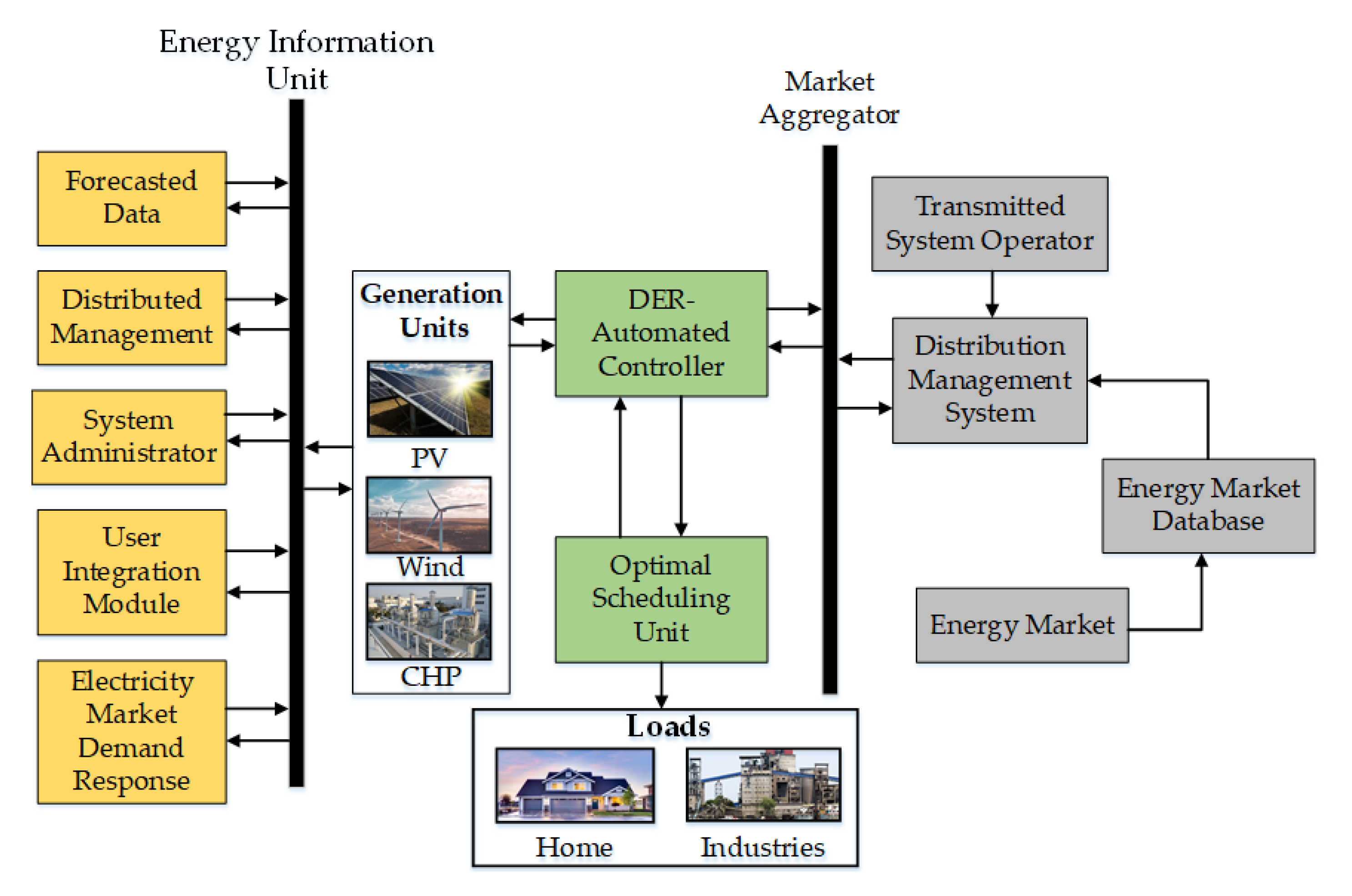

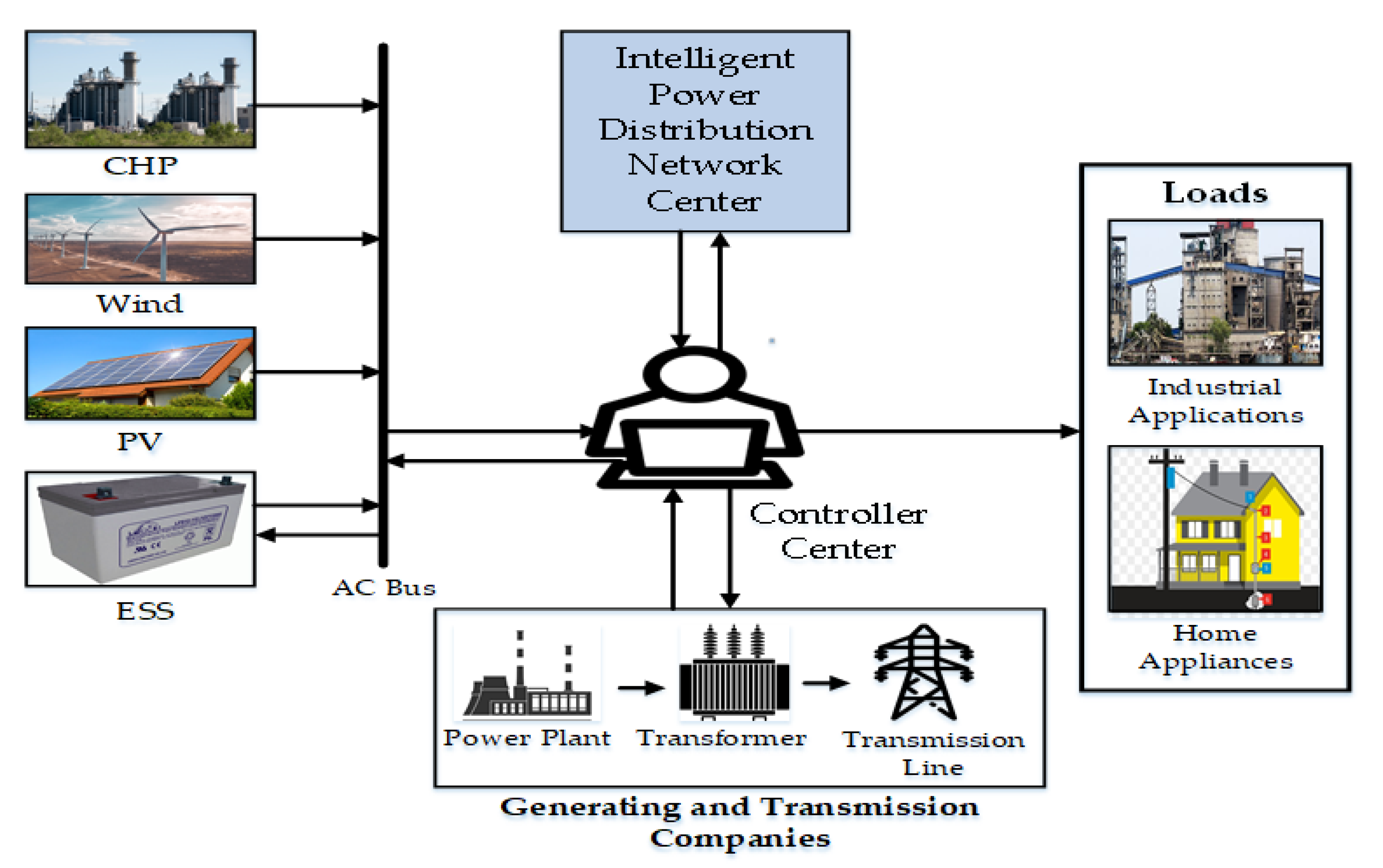
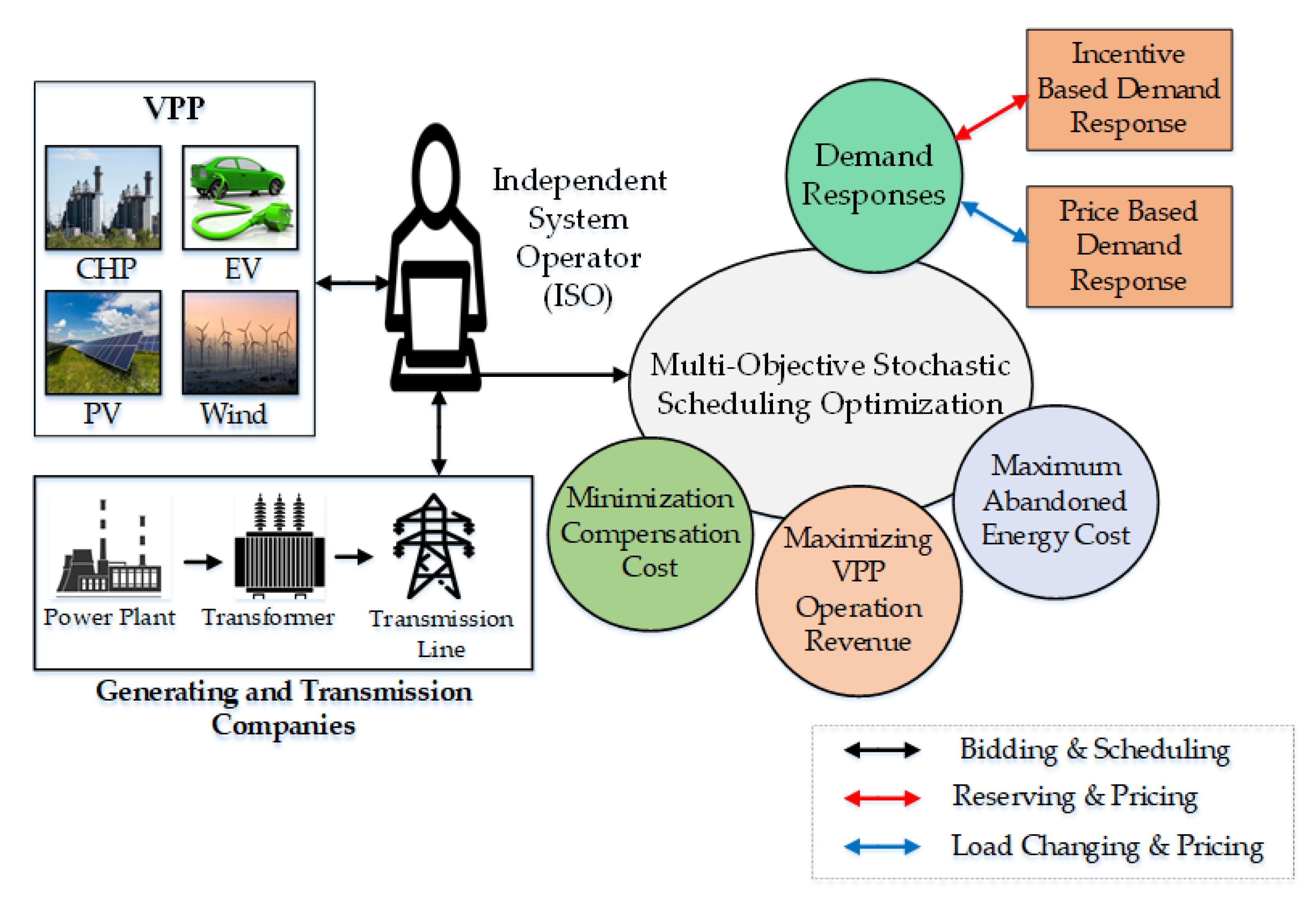
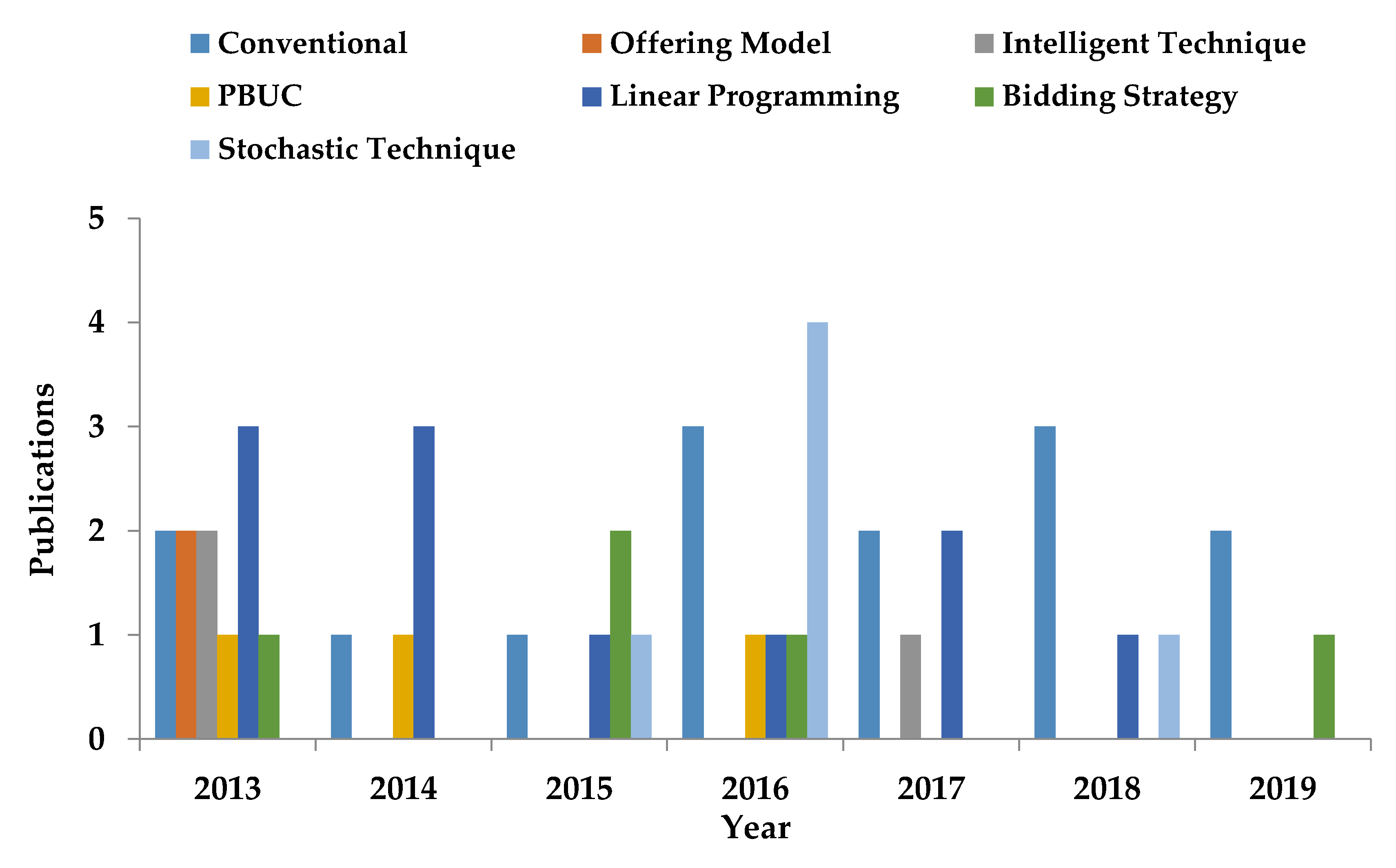
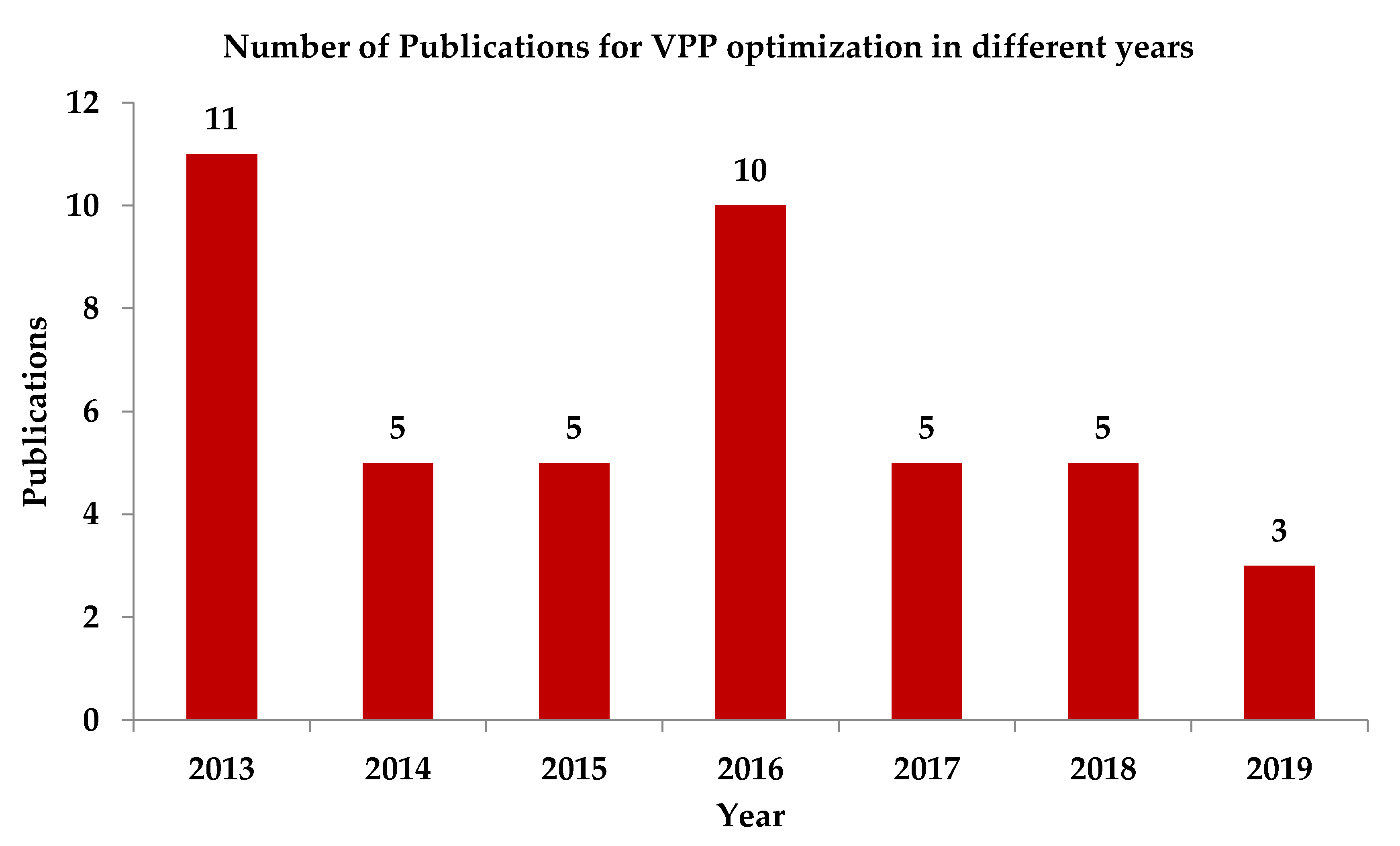
| Ref | Optimization Approach | System Configuration | Key Features |
|---|---|---|---|
| [40] | Energy management model | DER and ESS |
|
| [47] | A probabilistic method | Electrical and thermal energy resources |
|
| [60] | A novel demand response model | DER |
|
| [67] | Combined interval and deterministic optimization approach | Small scaled DER |
|
| [68] | Non-linear minimization techniques | CHP plant, electrical and thermal energy storage system, energy exchanger |
|
| [69] | Optimization algorithm | CHP, Renewable energy sources (PV, wind) |
|
| [70] | Non-linear programming based optimization algorithm | Wind power generation unit |
|
| [71] | A direct, hierarchical, and distributed control approach | DER |
|
| [72] | A market-based VPP model | DER |
|
| [74] | Optimal operation of VPP | DER |
|
| [75] | An adaptive load dispatching and forecasting strategy | Solar, wind, hydrogen, and thermal power system |
|
| [76] | Generation driver control strategy | Solar, wind, and energy storage system |
|
| [77] | VPP optimization scheme | DER and ESS |
|
| [78] | An optimization model for SAEV and VPP | Solar, wind, and dispatch generation units |
|
| [79] | Trip-prediction algorithm | Renewable energy resources (RERs) and ESS |
|
| [80] | The multi-objective robust scheduling model | WPP, PV, gas storage tank |
|
| [81] | Mixed rental-trading strategy | DER, Battery, and EV |
|
| [82] | Frequency regulation strategy | DER, flexible loads, and ESS |
|
| [83] | The two-stage optimal scheduling model | Energy storage system (Battery), Gas-fired microturbine, wind power generators |
|
| Ref | Optimization Approach | System Configuration | Key Features |
|---|---|---|---|
| [86] | Offering a model based on two-stages stochastic programming | DERs (wind and cascade hydro-power system) |
|
| [87] | Offering a model based on a two-stage stochastic mixed-integer linear programming scheme | DERs, storage facility, and a power plant (wind power plant) |
|
| [88] | Offering optimization model | WPP and storage unit (flexible loads) |
|
| [89] | Risk aversion model | WPP |
|
| Ref | Optimization Approach | System Configuration | Key Features |
|---|---|---|---|
| [46] | A multi-agent system (MAS) | PV, wind, biomass plant, EV, and ESS |
|
| [90] | Fuzzy multiple objective optimization algorithms | Renewable generation sources |
|
| [91] | Agent-based control | PV generator, wind turbine, battery, diesel generator, and CHP plant |
|
| [92] | Intelligent Auto-control System (IAS) | Distributed energy resources (DER) and flexible loads |
|
| [93] | A multi-agent system (MAS) | PV, battery, fuel cell, diesel generator, and micro CHP plant |
|
| Ref | Optimization Approach | System Configuration | Key Features |
|---|---|---|---|
| [2] | A probabilistic PBUC approach for optimal bidding of VPP | DER, ESS sand loads |
|
| [41] | PBUC model | Energy Storage, flexible loads, and CPP |
|
| [94] | PBUC model | PV, wind power plant, flexible loads, energy storage, and CPP |
|
| Ref | Optimization Approach | System Configuration | Key Features |
|---|---|---|---|
| [95] | Optimal bidding strategy for commercial virtual power plant (VPP) | Distributed energy resources (DER), battery storage systems (BSS) |
|
| [96] | Optimal bidding strategy based on mixed-integer linear programming algorithm | Solar, wind, and gas power plant |
|
| [63] | Bidding strategy for the non-linear mixed-integer programming model | DER |
|
| [97] | Optimal bidding strategy | Combined heat and power (CHP) and renewable energy resources (RES) |
|
| [98] | Bidding strategy | Wind power plant (WPP) |
|
| [100] | A mathematical model based on Benders decomposition technique | DER and VPP security constraints |
|
| [101] | Bi-level multi-objective approach | DER |
|
| Ref | Optimization Approach | System Configuration | Key Features |
|---|---|---|---|
| [37] | Mixed-integer linear programming (MILP) based optimization algorithm | DER, ESS, and CHP plant |
|
| [44] | An optimization algorithm | CHP system |
|
| [57] | Combined optimization algorithm | Micro CHP system and PV power plant |
|
| [59] | An agent-based approach for VPP based on linear programming | Wind power generator and electric storage system (battery) |
|
| [102] | Mixed-integer linear programming (MILP) optimization method | RER, ESS, and CPP |
|
| [103] | Two-stage stochastic mixed-integer linear programming based optimization algorithm | DER (PV, wind firms, micro-turbine, diesel generator, and battery banks) |
|
| [104] | Two risk management approach based interactive cooperation model | DER |
|
| [105] | Coordinated control strategy | PV and controllable loads |
|
| [106] | A risk hedging strategy for commercial VPP | DER |
|
| [107] | Multi-criteria operation strategy | Wind, solar, CHP, EV, and other electric storage systems |
|
| [108] | A novel optimal scheduling model based on two-stage stochastic mixed-integer linear programming | DER and ESS |
|
| [109] | Direct load control model based on linear programming | DER |
|
| [110] | Demand-side management (DSM) program | DER, ESS |
|
| [111] | Optimal dispatch scheduling | RES and CPP |
|
| [112] | A VPP model | Wind, solar, fuel cell, and battery storage |
|
| Ref | Optimization Approach | System Configuration | Key Features |
|---|---|---|---|
| [39] | Stochastic adaptive robust optimization scheme for offering strategy | DER, ESS |
|
| [48] | The stochastic profit-based scheduling approach | DER |
|
| [66] | A multi-objective stochastic scheduling optimization model | PV power plant, wind power plant, CPP, and EV |
|
| [113] | Two-stage stochastic programming based optimization algorithm | Wind energy and hydropower storage |
|
| [114] | A novel stochastic programming approach | DER |
|
| [115] | A bi-level stochastic scheduling optimization model | PV, wind, conventional gas turbine (CGT), and ESS |
|
| [116] | A stochastic and deterministic model | RES |
|
| [117] | A probabilistic model | Thermal and electrical resources |
|
| Ref. | Optimization Scheme | Offering Model | Intelligent Technique | PBUC | Bidding Strategy | Linear Programming | Stochastic Technique |
|---|---|---|---|---|---|---|---|
| [2] | Probabilistic PBUC approach | ✕ | ✕ | ✓ | ✕ | ✓ | ✕ |
| [37] | MILP based optimization algorithm | ✕ | ✕ | ✕ | ✕ | ✓ | ✕ |
| [39] | The stochastic adaptive robust optimization scheme | ✓ | ✕ | ✕ | ✕ | ✕ | ✓ |
| [41] | PBUC model | ✕ | ✕ | ✓ | ✕ | ✕ | ✕ |
| [46] | A multi-agent system (MAS) | ✕ | ✓ | ✕ | ✕ | ✕ | ✕ |
| [48] | The stochastic profit-based scheduling approach | ✕ | ✕ | ✕ | ✕ | ✕ | ✓ |
| [57] | Combined optimization algorithm | ✕ | ✕ | ✕ | ✕ | ✓ | ✕ |
| [59] | Agent-based approach | ✕ | ✓ | ✕ | ✕ | ✓ | ✕ |
| [63] | Optimal bidding strategy | ✕ | ✕ | ✓ | ✓ | ✕ | ✕ |
| [66] | Multi-objective stochastic scheduling | ✕ | ✕ | ✕ | ✕ | ✕ | ✓ |
| [86] | Offering model based on two-stage stochastic programming | ✓ | ✓ | ✕ | ✕ | ✕ | ✓ |
| [87] | Offering model based on two-stage stochastic MILP scheme | ✓ | ✕ | ✕ | ✕ | ✓ | ✓ |
| [88] | Offering optimization model | ✓ | ✕ | ✕ | ✕ | ✕ | ✕ |
| [89] | Risk aversion model | ✓ | ✕ | ✕ | ✕ | ✕ | ✕ |
| [90] | Fuzzy multiple objective optimization algorithms | ✕ | ✓ | ✕ | ✕ | ✕ | ✕ |
| [91] | Agent-based control | ✕ | ✓ | ✕ | ✕ | ✕ | ✕ |
| [92] | Intelligent Auto-control System | ✕ | ✓ | ✕ | ✕ | ✕ | ✕ |
| [93] | A multi-agent system (MAS) | ✕ | ✓ | ✕ | ✕ | ✕ | ✕ |
| [95] | Optimal bidding strategy | ✕ | ✕ | ✕ | ✓ | ✓ | ✕ |
| [96] | Optimal bidding strategy | ✕ | ✕ | ✕ | ✓ | ✓ | ✕ |
| [97] | Optimal bidding strategy | ✕ | ✕ | ✕ | ✓ | ✓ | ✕ |
| [100] | Mathematical modeling with Benders decomposition technique | ✕ | ✕ | ✕ | ✓ | ✕ | ✕ |
| [101] | Bi-level multi-objective approach | ✕ | ✕ | ✕ | ✓ | ✓ | ✕ |
| [109] | Direct load control | ✕ | ✕ | ✕ | ✕ | ✓ | ✕ |
| [102] | MILP optimization method | ✕ | ✕ | ✕ | ✕ | ✓ | ✕ |
| [103] | Two-stage stochastic MILP based optimization algorithm | ✕ | ✕ | ✕ | ✕ | ✓ | ✓ |
| [104] | Interactive cooperation model | ✕ | ✕ | ✕ | ✕ | ✓ | ✓ |
| [105] | Coordinated control strategy | ✕ | ✕ | ✕ | ✕ | ✓ | ✕ |
| [106] | Risk hedging strategy | ✕ | ✕ | ✕ | ✕ | ✓ | ✓ |
| [107] | Multi-criteria operation strategy | ✕ | ✕ | ✕ | ✕ | ✓ | ✕ |
| [108] | A novel optimal scheduling model | ✕ | ✕ | ✕ | ✕ | ✓ | ✓ |
| [110] | Demand-side management (DSM) | ✕ | ✕ | ✕ | ✕ | ✓ | ✕ |
| [111] | Optimal dispatch scheduling | ✕ | ✕ | ✕ | ✕ | ✓ | ✕ |
| [113] | Two-stage stochastic programming | ✕ | ✕ | ✕ | ✕ | ✕ | ✓ |
| [114] | Novel stochastic programming approach | ✕ | ✕ | ✕ | ✕ | ✕ | ✓ |
| [115] | Bi-level stochastic scheduling | ✕ | ✕ | ✕ | ✕ | ✕ | ✓ |
| [116] | The stochastic and deterministic model | ✕ | ✕ | ✕ | ✕ | ✕ | ✓ |
Publisher’s Note: MDPI stays neutral with regard to jurisdictional claims in published maps and institutional affiliations. |
© 2020 by the authors. Licensee MDPI, Basel, Switzerland. This article is an open access article distributed under the terms and conditions of the Creative Commons Attribution (CC BY) license (http://creativecommons.org/licenses/by/4.0/).
Share and Cite
Podder, A.K.; Islam, S.; Kumar, N.M.; Chand, A.A.; Rao, P.N.; Prasad, K.A.; Logeswaran, T.; Mamun, K.A. Systematic Categorization of Optimization Strategies for Virtual Power Plants. Energies 2020, 13, 6251. https://doi.org/10.3390/en13236251
Podder AK, Islam S, Kumar NM, Chand AA, Rao PN, Prasad KA, Logeswaran T, Mamun KA. Systematic Categorization of Optimization Strategies for Virtual Power Plants. Energies. 2020; 13(23):6251. https://doi.org/10.3390/en13236251
Chicago/Turabian StylePodder, Amit Kumer, Sayemul Islam, Nallapaneni Manoj Kumar, Aneesh A. Chand, Pulivarthi Nageswara Rao, Kushal A. Prasad, T. Logeswaran, and Kabir A. Mamun. 2020. "Systematic Categorization of Optimization Strategies for Virtual Power Plants" Energies 13, no. 23: 6251. https://doi.org/10.3390/en13236251
APA StylePodder, A. K., Islam, S., Kumar, N. M., Chand, A. A., Rao, P. N., Prasad, K. A., Logeswaran, T., & Mamun, K. A. (2020). Systematic Categorization of Optimization Strategies for Virtual Power Plants. Energies, 13(23), 6251. https://doi.org/10.3390/en13236251








